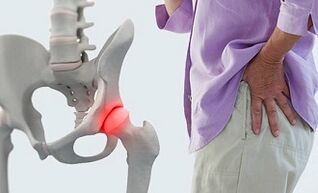
Our body is a complex system in which the breaking of a "screw" causes the failure of other "parts". In addition to diseases of the internal organs, chronic diseases of the musculoskeletal system, especially the joints, also cause many problems. Today I propose to discuss osteoarthritis of the hip joint. What are the symptoms and recommended treatments.
This joint is the largest in the human skeleton. It is constantly used when walking, bending, turning, so the disease brings severe pain and stiffness to the patient. Fortunately, with early diagnosis, the disease is well treated with medication. It is not so easy to suspect that something was wrong, it is necessary to know all the characteristics of the disease and to be able to discern the first manifestations. And, of course, take care of ways to prevent it and our article will help you with this.
Osteoarthritis or osteoarthritis of the hip joint is also called coxarthrosis, all these terms mean one thing: a complex progressive disease with destruction of the cartilage that lines the femoral head and the acetabulum. As a result, the joint gradually collapses, turns into bone, grows overgrown and loses mobility.
Coxarthrosis: what it is
Let's take a closer look at what coxarthrosis is, as this is the term doctors often use because recently the word "osteoarthritis" has been excluded from medical terminology, as it was previously believed that it had nothing todealing with inflammation, but scientists later proved otherwise. For us, these disputes are not important, the main thing is that all these names refer to the same very unpleasant disease.
So, coxarthrosis is a degenerative-dystrophic disease that causes the destruction and deformation of cartilage tissue. It is mainly diagnosed in women over 40 and in men - 60.
Why is it such an injustice that women have been wrong in the face of nature? The point here is in the special structure of the female skeleton and the load on the hip joint, especially during childbirth and childbirth. As a result, middle-aged women are more likely to suffer from this disorder; in the older age category, the number of patients of different sexes is gradually equalizing.
Causes of osteoarthritis of the hip joint
The reasons for the development of arthrosis in the hip joint can be many.
The most common are:
- heredity, if the parents or one of the relatives had such a disease, then you need to be more attentive to your health, since although the disease itself is not associated with genetics, a predisposition to metabolic disorders and other disruptions can causejoint problems;
- strong loads on the pelvis, especially in athletes who run, jump, lift weights;
- obesity, even a slight weight gain can be bad for the joints, which causes an increase in the load on them, so obese people are more prone to osteoarthritis;
- injuries, fractures, contusions of the pelvis;
- endocrine disorders such as diabetes can cause bone problems;
- inflammatory and infectious processes in the body, for example, purulent or rheumatoid arthritis;
- the presence of problems with the spine or bones (flat feet, scoliosis, osteochondrosis) that change posture and stress on the joints;
- hormonal imbalance;
- weakening of blood circulation in the tissues;
- sedentary lifestyle;
- old age, which is associated with a deterioration in tissue nutrition.
Degree of coxarthrosis
Doctors distinguish 3 degrees or stages of the development of the disease, which will help to distinguish the main symptoms. It is important to know that during the diagnosis in stage 1, it is quite possible to completely cure the disease and forget about it for many years, and in the third stage, the only correct decision will be an operation, otherwise the patient is threatened with disability.
Phase 1
The following symptoms will help establish the presence of osteoarthritis in the 1st degree hip joint:
- pain during and immediately after a heavy load on the joint;
- localization of pain only in the area of the bone junction;
- pace is not changed;
- no lameness;
- muscles retain strength and shape.
During computer diagnostics, the doctor may notice bony growths on the surface of the joint, especially along the inner and outer edges of the acetabulum. At this stage, correctly selected drugs allow you to fully restore the performance of the joint, but not all of us tend to rush to the doctor at the first manifestation of pain.
Admit it, a little discomfort often makes you think about stretching, dislocation, fatigue. We begin to rub the sore spot with various creams, ointments, we try to treat with folk methods, without understanding the cause and wasting precious time. Therefore, if you feel pain in your leg, the first thing to do is to go to the doctor, dedicating some time to yourself: this is the key to a long, fulfilling and happy life!
Phase 2
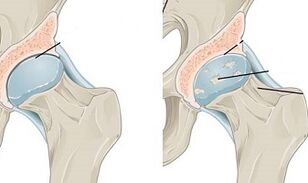
If the problem was not diagnosed and treated immediately, Grade 2 osteoarthritis gradually forms, characterized by the following symptoms:
- more frequent pain that can occur even with inactivity;
- pain is no longer limited to the bone connection area, it radiates to the thigh, groin, back;
- movements become limited, the person is unable to move the leg completely to the side;
- lameness appears.
During the examination, the images show bone growths at the edges of the cavity, an increase in the apex of the bone, its displacement and destruction of the edge.
Fortunately, with the help of complex therapy, 2nd degree arthrosis is still amenable to conservative treatment.
Phase 3
Well it's really bad for patients who have neglected their health so much that they have stage III osteoarthritis, it's typical of this:
- pain around the clock, even without physical effort;
- the need to use crutches or walking sticks;
- atrophy, i. e. shortening of the muscles of the diseased leg, change in posture.
During the examination, the doctor observes numerous bone growths, an increase in the size of the edge of the bone and a decrease in the joint space. And here there is only one way out - this is an operation to replace an already unusable joint with a special artificial prosthesis.
Signs
We have already briefly mentioned the symptoms of the disease, it remains to summarize all these symptoms.
Coxarthrosis occurs:
- severe pain in the joint, which may subsequently radiate to the leg, groin, knee;
- impaired movement, difficulty walking without support;
- shortening of the diseased limb;
- bad posture;
- reduced mobility of the affected joint;
- X-rays show muscle atrophy;
- MRI shows abnormalities in soft tissues, inflammation;
- CT scans for the presence of bone growths.
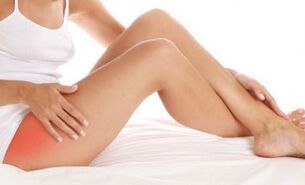
The symptoms are clear enough, but not so clear. Therefore, with any of these signs, it is necessary to consult a specialist to make a diagnosis, since it can be both osteoarthritis and completely different diseases with similar symptoms.
Diagnostics
Diagnosis of the disease should be done by more than one doctor, because pain in the pelvis can cause various ailments.
Then:
- the therapist may find chronic diseases that cause hip discomfort;
- a neurologist excludes or confirms the presence of intervertebral hernias, sometimes they cause the same symptoms that are characteristic of arthrosis;
- the urologist checks men for prostate inflammation, these disorders often also cause pain in the pelvis, which radiates to the legs;
- the gynecologist is looking for adhesions in the patient, they are also similar in manifestation to this disease;
- a rheumatologist is a narrow specialist who deals with such problems, he will help determine the stage of the disease, its causes and methods of treatment;
- The surgeon and orthopedist will come in handy in the late stage when the patient needs surgery.
Therefore, to make the correct diagnosis, it will not be possible to limit yourself to a visit to the doctor, and beyond that, it is still necessary to pass the tests:
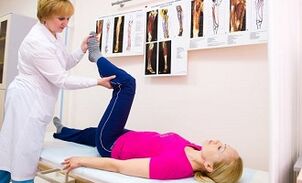
- clinical and biochemical analysis of urine and blood to detect inflammation in the body;
- MRI for soft tissue examination;
- CT for bone examination;
- X-rays will show bone damage;
- arthroscopy is indicated in some cases;
- sometimes an ultrasound of the pelvic organs is needed.
Success of treatment depends on correct diagnosis, degree of impairment and cause of the deformity. For example, if osteoarthritis caused tuberculosis of the bones, then usual therapy is prohibited, and in case of metabolic disorders, it is first necessary to eliminate the root cause and then fight its consequences.
Treatment of osteoarthritis of the hip joint
The most effective treatment is in the early stages, so you can limit yourself to various drugs. How to treat inflammation: the doctor decides after a series of studies. Therapy largely depends on the cause and degree of destruction, but mainly they try to relieve pain, remove inflammation, improve blood circulation, for this they use:
- non-steroidal drugs to relieve inflammation;
- analgesics to bring the patient back to normal life and make walking easier;
- muscle relaxants to restore blood circulation in the diseased area of the body;
- chondroprotectors, which help stop the deformation of cartilage tissue;
- steroid injections are used when pain intensifies;
- medicines for vasodilation.
In addition to pills, injections and ointments, treatment includes the use of a special diet and physical therapy, a number of measures helps to significantly improve the condition and restore leg mobility.
Surgery
If conservative treatment does not bring a visible result or the disease was diagnosed at the last stage, then there is only one way out - this is an operation. The procedure is complicated, in rare cases rejection is possible or the risk of thromboembolism and other life-threatening complications. At the same time, for seriously ill patients, this is the only possibility for a normal life, because with an artificial joint, after healing and rehabilitation, a person will be able to move calmly.
As with any operation, a patient with coxarthrosis must prepare in advance for general anesthesia, he is not allowed to eat or drink before the procedure, and the intestines are cleaned. Then his legs are wrapped with elastic bandages to avoid edema, placed on his side and immersed in sleep. Next, the doctor makes an incision on the thigh, opens access to the joint, cuts the head of the femoral bone and inserts a pin into the cut, to which the titanium head is attached.
Damaged pelvic bone tissue is also removed and replaced with a polymer pad to allow for normal leg movement in the future. After that, the wound is sutured, a bandage is applied on top. After healing, a recovery period still follows, but in the absence of rejection, a person can walk for 20 years, or even for life, walk calmly with an artificial joint, without experiencing pain and stiffness.
Chondroprotector
Due to the disease, the hip joint loses its mobility, changes in the tissues, destruction of cartilage and the formation of bone growth in its place are observed. Fortunately, effective drugs have been invented to restore cartilage tissue, they are also called chondroprotectors, which in Latin means "cartilage protection".
So what are these drugs capable of?
- stop the process of destruction of cartilage tissue;
- accelerates metabolism in the joint;
- stimulates the production of synovial fluid, that is the natural lubrication, which normally occurs in the cartilage tissue and promotes an easy sliding of the bone in the joint
- relieve inflammation;
- facilitates joint movement.
Preparations may contain two main components: glucosamine and chondroitin.
As for the form of the drug, it can be different, from tablets, capsules, ointments, creams to solution for injections. The choice of medicine, dosage and duration of use should be prescribed by the attending physician, taking into account the characteristics of the organism. But, as a rule, injections are used during exacerbations, then the patient is transferred to a more gentle treatment, which can last for months, at least six months. After all, the restoration of cartilage tissue is a long process, but it allows you to return freedom of movement without surgery.
Injections
In some cases, the treatment of the disease involves injections. Only a doctor should do them, resorting to such a solution only in extreme cases, since it is risky to treat the disease in this way. The fact is that the space between the bones in the hip joint is small, and with coxarthrosis it narrows even more. As a result, sometimes even an experienced doctor cannot get into the joint capsule itself, and the risk of touching the nerves and blood vessels is great.
At the same time, injections are sometimes the only way to relieve pain and inflammation, several drugs are used for these purposes:
- corticosteroids for pain relief, such injections can be given no more than once every two weeks and a cycle not exceeding 7;
- chondroprotectors help restore tissues, stimulate the production of synovial fluid for normal bone flow and improve tissue elasticity. In the form of an injection, drugs act faster than tablets or ointments, allowing the drug to be delivered directly to its destination
- hyaluronic acid is the ultimate method for relieving inflammation and pain. It is used after all other drugs have been tried and have not achieved the desired result, the effect of its use is long-lasting, the injection is done once.
Physiotherapy
Unfortunately, in the fight against osteoarthritis of the hip joint, physiotherapeutic procedures are ineffective due to the deep litter of the affected area. However, doctors sometimes prescribe kinesitherapy to relieve pain.
Massage
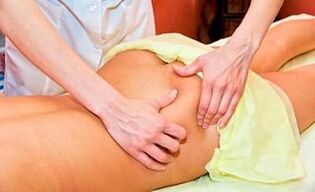
If a medical massage is performed by a professional, it helps to improve blood circulation in the joint, restore mobility and stop tissue destruction. But its use is indicated only exclusively during the period of remission, during the absence of pain.
In addition, to achieve a clear effect, one-time visits to a specialist are not required, but courses two or three times a year to maintain the condition of the bones and joints.
Treatment of coxarthrosis with folk remedies
Although it is quite difficult to completely cure coxarthrosis in the hip joint using only folk remedies, especially in a severe and advanced form, doctors also recognize the effectiveness of natural medicines. Many formulations based on herbs, roots and essential oils significantly relieve the condition of a sick person, stop the destruction of cartilage and the formation of bone and scar tissue, stimulate the production of synovial fluid, which is very important in the fight againstthe illness.
In order for the treatment to be more effective and give positive results, it is worth discussing with the doctor what alternative methods can be used independently at home.
Some of the most popular tools:
- Perestroot ointment. To prepare it, the root must be crushed in a coffee grinder, mixed with melted pork fat in a ratio of 2: 3, boiled over low heat for five minutes, cooled and lubricated with the sore spot composition in the evening for a month. Then rest for a week and continue the treatment;
- ointment with celandine - dry 7 plants, separate the leaves from the stems and grind, add 1 cup of olive oil, leave in the cold for 14 days, after which the medicine will become gelatinous, melt in the hands. Lubricate the diseased area with a substance every evening;
- birch leaves, lime blossom, dried parsley, mince, make tea instead and drink every day;
- wash the lemon, chop it and pour it into 1 liter. boiling water, strain after a couple of hours, add honey, drink three times a day;
- combine honey, iodine, ethyl alcohol and glycerin in the same amount, insist 3-4 hours, lubricate the skin on the joint with a cotton swab 3 times a day;
- take 60 grams of cinquefoil and elecampane roots, mix with 0, 5 liters. vodka, insist for a day in a dark cool place, strain, drink 25-30 drops three times a day 30 minutes before meals, you can also use it to rub.
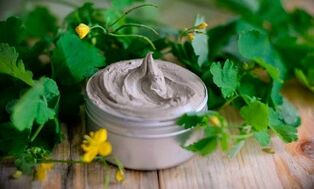
Exercises for coxarthrosis of the hip joint
Specially selected exercises will help to significantly improve the condition of coxarthrosis, some will be suggested by the doctor. Before using them, you need to consult with your doctor, since with an incorrectly selected complex and the presence of contraindications, you can cause even more harm to your health.
For example, deforming osteoarthritis is dangerous to treat with physical exertion - it is fraught with even greater pain and tissue destruction.
Gymnastics is also prohibited when:
- exacerbation of the disease;
- evident pain on movement;
- increase in body temperature;
- exacerbation of chronic diseases;
- menstruation;
- hernia;
- severe heart and lung disease.
It is believed that therapeutic exercises for coxarthrosis should be aimed at restoring muscles and ligaments, but not at loading an already weak joint, therefore not dynamic, but static movements are more suitable. I am also glad that the set of exercises can be performed at any convenient time, without spending money and nerves on trips to specialists, and given their effectiveness, it will simply be a crime not to use such a universal medicine.
Here are some exercises:
- lying on your back, lift the affected leg 10-15 cm, freezing for 20-30 seconds, repeat for the other leg;
- performs the same movement, but quickly, holding the legs only for 1-2 seconds;
- to lift not a straight leg, but a leg bent at the knee at a right angle;
- lying on your stomach, take your legs off the floor and hold the position for a couple of seconds, slowly spread your sides, connect again, lower on the floor;
- lying on your side, bend the lower leg and lift the upper leg and hold it at an angle of about 45 degrees, wait 30 seconds, return to the starting position, repeat for the other leg;
- performs the previous exercise, but at the same time turns the foot alternately in and out.
True, it is not recommended to practice only the description of exercises and videos, it is better to discuss this point with a doctor or even to visit a rehabilitation specialist several times, since in case of a different type of disease it is necessary to adjust the complexto avoid complications.
Nutrition
Since osteoarthritis is largely dependent on metabolism, it is important to stick to proper nutrition when treating the disease. It should be frequent, but not abundant. Excluded:
- salty foods;
- fatty broths, mayonnaise, oils, dairy products (sour cream, cream);
- preservatives;
- premium flour baked goods;
- smoked.

They should be replaced with more cartilaginous ones:
- milk and low-fat dairy products, especially cheese, are very important as it promotes tissue regeneration and calcium absorption;
- lean meat and fish;
- beans, mushrooms, buckwheat, lentils rich in vegetable proteins;
- jellied meat, jellied fish, jellies, which contain collagen;
- carbohydrates from cereals;
- vegetables, fruit;
- complex carbohydrates (nuts, honey).
Drinking plenty of fluids is important for maintaining the salt balance.
Proper nutrition helps to remove uric acid which is dangerous for the joints, relieve inflammation, remove excess weight, edema and thus reduce the load on the diseased area and even restore cartilage tissue. The maximum effect can be achieved in stage 1 of the disease.
Prevention
If there are cases of disease in the family or if osteoarthritis of the hip joint is already present and it has been successfully treated, correct and regular prevention is important, which consists of the following points:
- proper nutrition, which contains all the vitamins and minerals for normal metabolism in the tissues;
- weight control to avoid additional loads;
- Moderation of physical exertion, the ability to move in such a way as to avoid injuries and overloads to the diseased joints;
- beware of hypothermia, as it can aggravate. It is important to dress warmly, wrap the bowl in cold weather, avoid sitting on cold surfaces and being in a draft;
- lead a healthy lifestyle, walk in the fresh air, gently strengthen the leg muscles.
Osteoarthritis is a very unpleasant disease which, without proper treatment, ends up in disability and life in a wheelchair with bone fusion. Therefore, at the first symptoms, go to the doctor for diagnosis and help. Timely and comprehensive treatment allows you to get rid of the problem and live without pain and restrictions.
























